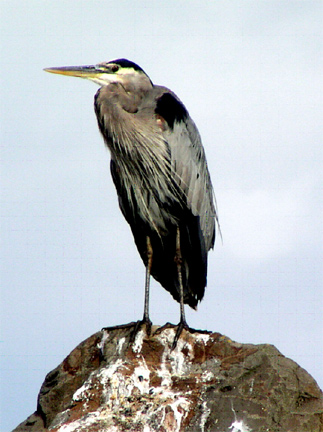|
Great blue herons, Ardea herodias, can often be seen in the shallows of Netarts Bay, standing majestically, surveying their surroundings, staring into the water, or striding in slow motion in search of food. If you watch them long enough, you will see one stab or spear a fish or shrimp with its long, yellow bill, then juggle it into the best position for swallowing. If the fish is large, the heron will carry it to shore to pick at it. Herons seem ungainly, with their wings too large for their thin bodies as they struggle to gain flight. Yet once aloft, they are rather graceful. Common all year in the bay, herons may be seen a dozen or more at one time from the Netarts Bay Road that runs along the east side of the bay. swallowing. If the fish is large, the heron will carry it to shore to pick at it. Herons seem ungainly, with their wings too large for their thin bodies as they struggle to gain flight. Yet once aloft, they are rather graceful. Common all year in the bay, herons may be seen a dozen or more at one time from the Netarts Bay Road that runs along the east side of the bay.
The great blue heron, or GBH as birders often call it, is a large wading bird, weighing up to five and a half pounds and stretching to more than four feet in length. The Pacific Northwest subspecies, fannini, ranges along the Pacific Coast from Southern Alaska to the tip of Baja California. It is darker than others in the U.S. and has a shorter bill. Its back and wings are blue-gray, with black shoulder patches and a black tail, and its neck is gray-brown with black streaks on the underside. Its head is white except for a black crown and occipital plumes. When perched or in flight, it commonly bends its long neck in an “S” shape, as seen in the picture.
Great blue herons breed in rookeries, called heronries, often but not always in trees. During the spring, the female lays two to seven eggs that hatch in about a month. Chicks fledge after another two months, mature in two years, and live to about fifteen years. Males are usually larger than females. Herons feed both day and night, but mostly at dawn and dusk, eating mainly fish but also crustaceans, amphibians, reptiles, insects, other birds, and small mammals. They are quiet birds except when they take flight, often emitting a loud “kraaak” as they become airborne.
http://www.geocities.com/Heartland/5960/bheron.html
Text and photograph by Jim Young
Oceanside, Oregon
jsy4990@embarqmail.com
|

